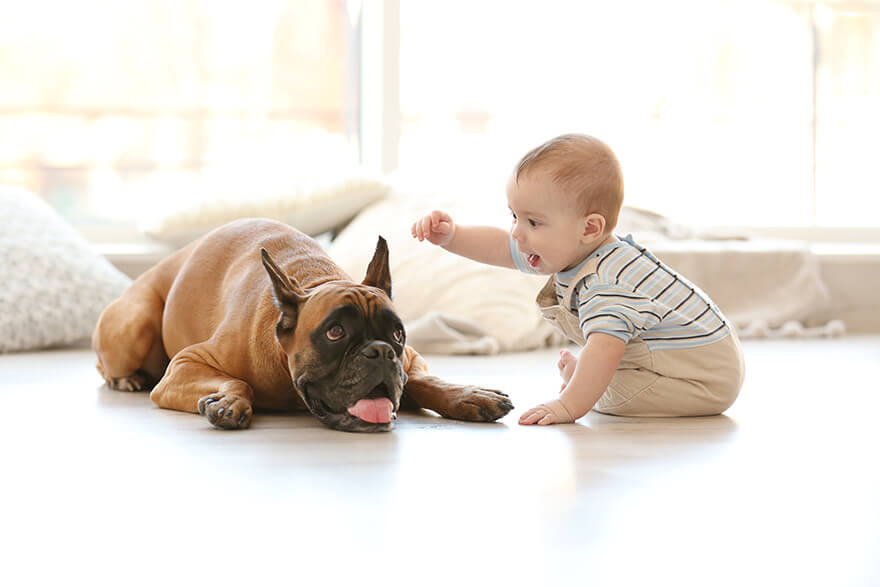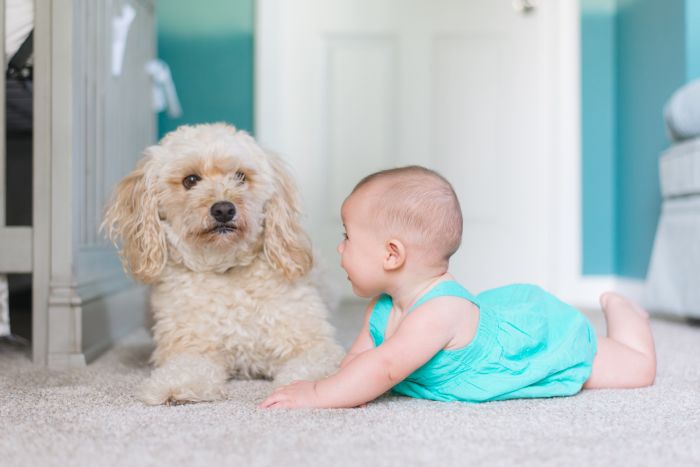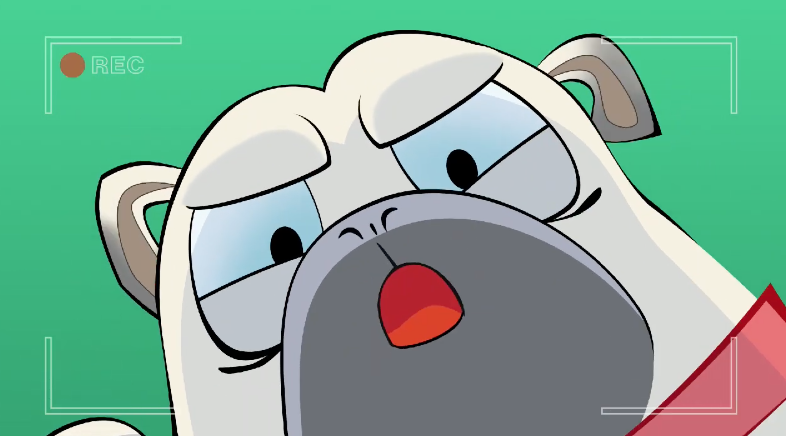

Barks & Babes: How to Prepare Your Dog for a New Baby
There are countless benefits to raising a baby with a dog, but before we introduce them, there are a few things worth knowing! Let’s delve into the many advantages, the fears, and some calming guidelines for that first meeting between your pup and your newborn.

Writer Roi Kadosh
9 min read

Congratulations, a sweet little baby is about to join your family. Naturally, you have questions and concerns (and maybe even some fears) about the future, and that’s perfectly normal (for everyone). But for dog parents who are also about to become human parents, there are even more questions and fears. So the first thing we’ll do is reassure you, and then we’ll help make things clearer. After that? Who knows… Maybe your little one’s first word will even be “woof”…
The benefits of raising a baby with a dog
Yes, we know that you know, but still, some things need to be stated plainly. A baby raised alongside a man’s best friend benefits in ways that can’t quite be attained anywhere else. Like what, for instance? Here are a few examples.
A baby raised with a pet develops a strong immune system
Countless studies have shown that a “dirty” environment actually helps babies build and develop a stronger and more stable immune system, as compared to babies raised in sterile surroundings. Floating fur on the floor or carpet, slobber from wet kisses, grass clippings from a romp in the dog park, and even asphalt dust stuck to your dog’s paws- all these daily exposures encourage young immune systems (especially in the crawling stage) to produce antibodies against pathogens and reduce overall sensitivity to allergens they’ll encounter later in life.
Eye-level socializing
Babies are basically really small people. Naturally, they’re also really (but really!) short. To adopt their perspective, our eyes need to be about knee-level, and from down there, the world looks… well, different. But people, even small ones, need social interactions and connections to function in the world, and what’s better than a connection at eye level? In this game, dogs win. A dog interacts with a baby, cuddles up to them, offers unconditional love, and backs off or yelps when hurt by the baby. Isn’t that the perfect socializing process? The social behaviors a baby learns from their four-legged friend will be applied later to younger siblings, preschool friends, and even coworkers, though they pale in comparison.

Better than a developmental toy, more effective than a fancy ‘play gym’
We already mentioned “eye-level”, but the height of a dog also plays an important role in a baby’s physical development, since babies are naturally curious. Imagine yourself back in infancy (no need for a hypnotic pendulum, nor a wagging tail). Something furry and pleasant is moving in front of you, sniffing you, licking you, gazing at you with adoring eyes, and offering its toys. Of course you’d want to follow it, see what it’s doing in the other room, and find out what that orange squeaky toy is. Daily interaction with a dog stimulates a baby’s curiosity, encouraging them to follow with their eyes, roll over, lift their head, crawl… and eventually, run. And the bonus? No annoying jingle from that psychedelic-colored rolling ball.
A reliable cleanup crew always on alert
When your baby reaches the stage of self-feeding, you’ll appreciate having a dog around. Babies love to throw things on the floor (yes, even food; maybe especially food), and dogs love a food shower. Just make sure the dog doesn’t eat anything that might be harmful to them.
A reliable monitoring and balancing system
This one is truly amazing. Dogs are capable of sensing the emotional and physical state of their loved ones. Dogs are domesticated animals who have always lived alongside humans and under their care. They therefore developed these remarkable abilities simply because they had a clear interest in keeping their owners safe (let’s not kid ourselves… there are no “pure” motives in nature). Dogs sense changes in heart rate, recognize rising stress levels, are alert to distress- and sometimes, they know how to respond too. Petting a dog can slow the heart rate, reduce cortisol levels, and balance blood pressure. Moreover, a dog’s behavior can indicate when a baby is in distress, help calm the baby, and even aid mothers dealing with postpartum depression. Isn’t that amazing?
Fears can come back to bite you
Is the whole new baby scary? Of course it is! Any change can be scary, even if it’s a positive and desired one. But just like in the Animal Kingdom, fear is a natural and important mechanism meant to serve us. So first of all, it’s important to acknowledge it and legitimize it. Once we understand that it’s okay to be afraid, and that fear should motivate us to act instead of making us freeze up, we can do something productive about it.
If your fear is that the dog will be upset about the change (“I’m no longer the center of attention, give me love”), or that the dog will accidentally or intentionally hurt the baby (“I’m not jealous, I’m just clumsy”), or simply that you want to maintain hygiene around the baby- Animalia Pet Insurance is here to give you an interesting perspective, plus a few useful tips.
From the dog’s perspective
Is a dog’s natural reaction to encountering a new baby jealousy, or is it perhaps affection and empathy? It depends on who you ask. It’s important to know that mammals can recognize the babies of other mammals. We’ve all seen those adorable videos of tigers caring for baby monkeys- this doesn’t happen by accident. Their primary instinct is to protect a helpless pup. Your dog will notice that the baby is something new, different, and rare, and they will react accordingly. That’s where we (meaning you) come in, with the responsibility to positively reinforce, bring closer, let them sniff, introduce, and most importantly- project calmness (more on that later).
Now let’s talk about jealousy: from the dog’s point of view, changes are happening that affect both their pack and their territory. Jealousy? Not quite. Dogs don’t get jealous and certainly don’t do things out of spite (that’s a human trait, y’know). They simply react to the situation naturally. There might be scenarios in which the dog sees the baby as an intruder to the “pack’s” territory. For example, noticing that this noisy invader often stresses out the “leaders”. Since the dog is loyal to the pack and its leaders, it may therefore feel threatened by the “intruder” and react accordingly. But don’t worry, this situation can be avoided. We’re about to explain how.

So how do we make it work?
Alright, we get it- dogs aren’t humans. But still… How do we make it work?
First and foremost, stay calm! Your dog will read you and your partner’s behavior and respond accordingly. So it’s important to be a bit more chill about the situation. This way, the dog will also be calm. And who knows, maybe even the kids will pick up on that chillness, which is certainly needed in our crazy world.
Before the birth
It’s important that the dog becomes familiar with the changing environment before it fully changes. Let them hang around while you assemble the crib, explore the new stroller, understand what happens when the wheels move, and adjust to the “bombardment” of new smells- diapers, new bedding, and baby clothes.
After the birth
If possible, bring home some baby clothes or a swaddle cloth that’s been with the baby before you bring them home. Let your dog sniff it and get to know their new sibling’s scent. And what about attention? You can go on long walks together, with the baby in a stroller or carrier and the dog on a leash- everyone wins. Another option is to spend quality time with your dog while the baby is with a grandparent, aunt, or your partner. The goal is for everyone in the household to give the dog balanced attention.
The first meeting
By now, you’ve probably realized- first dates that go well make everything smoother later. But even a rocky start can turn into a love story. For that first meeting between the baby and the dog, make sure the dog’s calm. If possible, engineer the situation so that the baby is waiting at home when the dog arrives, not the other way around. Allow the dog to gently approach and sniff, reward desired behavior with a pet or a treat, and pay attention to warning signs. If you see any, make sure to respond accordingly and move away if necessary. In any case (but especially if you’re worried about how the dog will react to the baby), we recommend involving an experienced dog trainer in the proceedings.
Important warning: The first meeting is not the time to take pictures, pray for miracles, or take risks. Take it slowly and gradually to let the dog adjust in their own good time and comfort.
How do you know when the dog isn’t comfortable?
Even on four legs, it’s not always smooth sailing. Even if you “follow the rules”, the dog might still feel stressed, so it’s important to be aware of their body language. Remember, there’s a gentle soul there whose world has just been turned upside down. Your dog needs your empathy and help navigating this new situation. If you notice unusual body language- yawning, raised hackles, repetitive licking, tail tucked between legs, ears pulled back, averted gaze, panting, tense facial expression, or growling- it’s time to help the dog get out of the stressful situation. It’s also important not to suppress warning signs- they’re there to protect both the dog and their pack.
Sure, we’re great at dog insurance, but there are things we can’t guarantee- like the transition being smooth or the hair on the baby blanket being welcome. What we can definitely guarantee, though, is that your pup and baby will spend many happy years together, as our coverage will make sure that every time something unexpected happens, your dog will get the care they deserve.





We offer the most
comprehensive coverage
out there
car with a spare tire for life’s bumps.
Having Animalia is like a pimped-out
Rolls Royce with a swimming pool
in the trunk.



Get your pet insurance quote
Pet type
- Dog
- Cat
What is your pet's name?
Zip code





